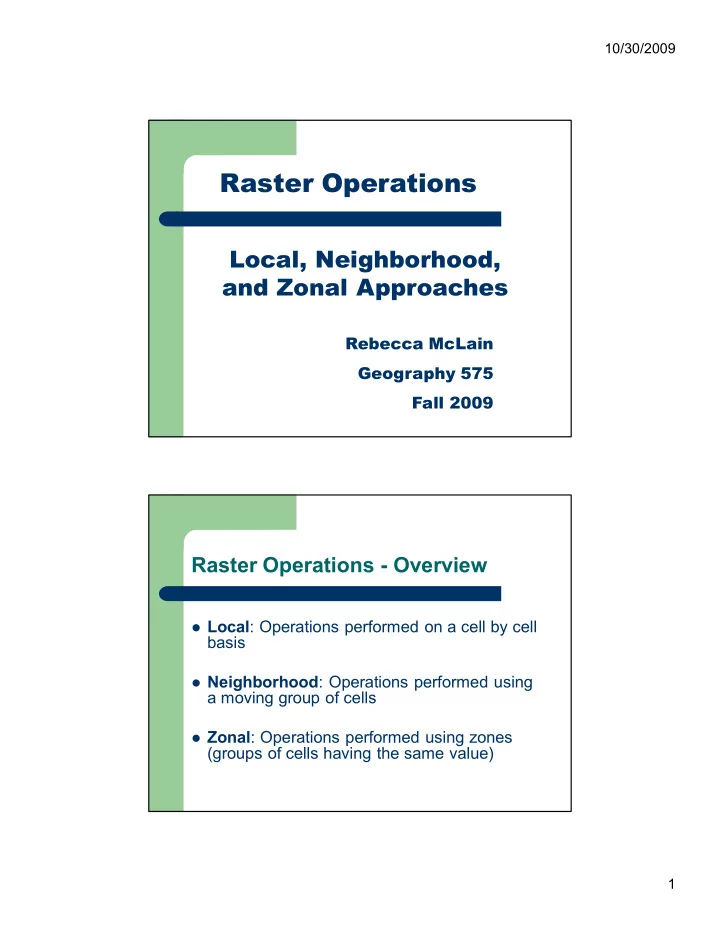

10/30/2009 Raster Operations Local, Neighborhood, and Zonal Approaches Rebecca McLain Geography 575 Fall 2009 Raster Operations Overview � Local : Operations performed on a cell by cell basis � Neighborhood : Operations performed using a moving group of cells � Zonal : Operations performed using zones (groups of cells having the same value) 1
10/30/2009 Local Operations Overview � Cell by cell operations � Computes output cell values as a function of the input cell values � Can be done using single or multiple rasters � “No data" cells not included in calculations � Common uses: reclassification and overlays Local Operations – Reclassification (single raster) Onetoone change – input raster cell value is replaced with new value in the output raster (integer rasters only) Diagram adapted from ESRI ArcGIS 9.3 Helpdesk 2
10/30/2009 Local Operations – Reclassification (single raster) Range of values – a new value is given to a range of values in the input raster (integer and floating point rasters) Diagram adapted from ESRI ArcGIS 9.3 Helpdesk Reclassification Applications Simplification (creating groups for analysis) Replace values based on new information Create common scales for ranking data values (ex: creating suitability classes) 3
10/30/2009 Local Operations – Multiple Rasters Operation: add raster 1 and raster 2 cell values to produce an output raster with the summed cell values Diagram adapted from ESRI ArcGIS 9.3 Helpdesk Local Operations – Multiple Rasters Examples of operations that can be done using multiple rasters: mathematical functions summary statistics Combine operation (Combines rasters by assigning a unique output value to each unique combination of input values). Applications : change detection studies; predicting habitats favorable for wildlife species 4
10/30/2009 Neighborhood (focal) Operations � Uses values for the cells within the neighborhood to calculate the value for the focal cell � Focal cell moves from cell to cell � Applies to single rasters � Can produce summary statistics � “No data” cells not included in analysis � Common shapes used for neighborhood analysis: Diagram from ESRI ArcGIS 9.3 Help Desk Neighborhood Operations Operation: Summation (including value of focal cell) Neighborhood size: 3 x 3 rectangle; red circle = focal cell Gray square = no data for that cell’s value Diagram adapted from ESRI ArcGIS 9.3 Helpdesk 5
10/30/2009 Neighborhood Operations Operation: Summation (including value of focal cell) Neighborhood size: 3 x 3 rectangle; red circle = focal cell Gray squares = no data for that cell’s value Diagram adapted from ESRI ArcGIS 9.3 Helpdesk Neighborhood Operations Common Applications � Data simplification � Terrain analysis � Image processing � Site selection 6
10/30/2009 Zonal Operations � Involves groups of cells with the same values or similar features (zones) � Cells do not need to be contiguous to be in a zone � Can be used with a single raster or with two rasters Zonal Operations � Single raster zonal operations – Measures the geometry of each zone (area, perimeter, centroid, thickness, etc.) � Two raster zonal operations Involves an input raster and a zonal raster to produce a new raster that summarizes cell values in the input raster by zone 7
10/30/2009 Zonal Thickness – Single Raster Example Answers the question: ”How far you can run into a forest at its deepest point before you are running out of it?” (ESRI ArcGIS 9.3 Help Desk). Zonal Operation – Two Raster Example Example application Zone layer – soil type Value layer – vegetation type Output table – Number of vegetation types associated with each soil type Diagram from ESRI ArcGIS 9.3 Helpdesk 8
10/30/2009 Zonal Operations Applications * Landscape ecology analyses * Comparisons of data sets using descriptive statistics Raster Operations: Quiz Questions 1. List two reasons for doing reclassification and provide a real world example of each. 2. Overlaying is another term for a ___ operation using multiple rasters. 3. True or False: Neighborhood operations are used to compare summary statistics from two or more rasters. 4. Fill in the blanks: ___ operations work with groups of cells of same values; ____ operations are cellbycell operations; and ___ operations involve moving groups of cells. 9
10/30/2009 Raster Operations: References Chang, K. 2009. Raster data analysis. In: Introduction to geographic information systems. McGrawHill. New York, NY. Pp. 248267. ESRI. 2002. Using ArcGIS spatial analysis. Redlands, CA. Pp. 164189. ESRI ArcGIS 9.3 Help Desk. http://webhelp.esri.com/arcgisdesktop/9.3/ (Accessed 102309). 10
Recommend
More recommend